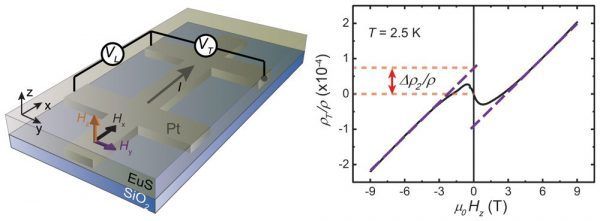Strong interfacial exchange field induced by EuS ferromagnetic insulator measured in combination with heavy metals
Spin-dependent transport at heavy metal/magnetic insulator interfaces is the origin of many phenomena at the forefront of spintronics research. A characteristic feature of these heterostructures is the spin-dependent scattering of conduction electrons that gives rise to non-equilibrium but stationary states with non-uniform distribution of electrons with different spin orientations. Maintenance of this imbalance is achieved via dynamic separation of electrons and can be considered as a steady flux of spins (spin current). The concept of spin currents is widely used to describe many different phenomena such as spin pumping, spin Seebeck effect or spin Hall magnetoresistance. Furthermore, it is of key importance for the development of spin-torque – based devices such as magnetic random-access memory (STT-MRAM), currently ready for mass production.
Despite the importance of spin currents, there are not many heterostructures capable of generating this effect. Insulating magnetic materials (MI) are abundant, but the majority of them are ferri- or antiferromagnets, where the competing contributions from interfacial moments of opposite orientation complicate or cancel the net effect. Furthermore, archetypical insulating ferrimagnets like garnets have very complex crystal structures that complicate the growth of thin films with low density of defects, a crucial ingredient of high-quality heterostructures. For this reason, the development of a suitable technology for the growth of the ferromagnetic insulator EuS, accomplished by researchers of the Nanophysics lab, at CFM, is a crucial achievement.

Figure: Scheme of the fabricated Hall-bar devices and transverse resistivity measurement in Hall configuration. Dash purple lines correspond to the linear fit performed at large magnetic fields and extrapolated to zero. The red arrow shows the clear Δρ2/ρ.
Heterostructures of Pt/EuS were grown and patterned in Hall bars shape in collaboration with the Nanodevices group at CIC nanoGUNE. Generation of spin current in these devices was studied via measuring of Spin Hall magnetoresistance (SMR) at low temperatures and in high magnetic fields. The theoretical model developed by researchers of the Mesoscopic Physics group at CFM allowed to quantify all three parameters defining the spin current through the interface: the spin-sink conductance Gs, which originates when the electron spins of the nonmagnetic metal are collinear with the MI magnetization and both the real and imaginary parts of the spin-mixing conductance G↑↓ = Gr + i*Gi, which originate from torques that the electron spins of the nonmagnetic metal exert to the magnetization of the MI when they are noncollinear. Gr is determined by the Slonczewski (or damping-like) torque, a quantity crucial for the spin−torque devices. On the other hand, Gi quantifies the exchange field between the electrons of the nonmagnetic metal and the magnetic moments of the MI, exerting a field-like torque when spin accumulation is induced. This interfacial exchange field is very relevant in different areas. For instance, when the nonmagnetic metal is a superconductor, it leads to a spin-splitting field, even in the absence of an external magnetic field.
A key finding of the work was a first time experimental demonstration that in ferromagnetic MI such as EuS, Gi is larger than Gr and at least 3 times larger at the lowest measured temperature (2.5K), as was predicted theoretically for europium chalcogenides. It was confirmed that the field-like torque plays an important role in Pt/EuS because all magnetic moments of the interface contribute to the interfacial exchange field, as opposed to the ferrimagnetic case, where there is a compensation of the magnetic moments.



